I see some photos at [
here].
I'll have to post some pictures of mine once it's put back together. Mine is the dark gray variant. They're interesting systems. They even support a single full-length 8 or 16 bit ISA option card; a detail I'm surprised isn't discussed more when talking about these.
That's a neat site. I hope they get the floppy drive working. I was lucky that mine works well. I wonder if they know you have to push the button in after inserting a disk before it will read. It's not very intuitive. You press it again to eject the disk. Something else interesting in their article is those bodge wires. My motherboard doesn't them. I wonder if it's a different revision of the board or if someone did repairs that required bypassing some damage.
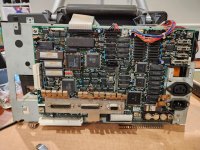
What are the model numbers of both?
The controller board has "DUNTK 1693 ACZZ" at the top. There's another number on the lower left corner, but the motherboard has the same number, so I don't think it identifies the controller specifically. The main controller chip is a NCL NDC864. I only know this is the main controller IC because of the technical service manual. Unfortunately the manual doesn't go into detail about how the drive is detected or configured. At least not in any terminology that I understood.

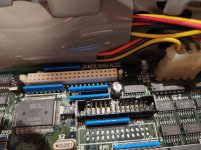
The drive is a JVC JD-3824R0S0. I found
this site and
this site that have some information on the drive, including the pinout and other info. The second site mentions that the drive won't spin up without being initialized by the controller, so does that indicate that the controller is at least aware that the hard drive is there or is it blindly issuing commands?
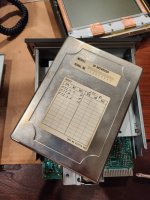
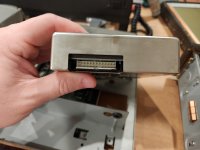
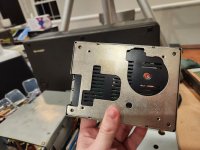
That may be the result of the hard drive doing a self test when it receives power.
How to tell: Disconnect the data and control cables from the drive, then apply power, then listen out for the same sounds.
Unfortunately, the drive uses the same cable for power and data. I could apply 12v/5v to the correct pins using the pinout from those sites, but it sounds like the drive doesn't spin until commanded to by the controller.
Allowable hard drives will be under the control of the hard disk controller. Per [
here], there
may be jumpers or switches on the controller. The user manual for the controller should reveal a lot.
There is a jumper labeled "JP21". It has 3 positions that are labeled "4 5 6". The jumper is at position "6". I haven't touched this jumper. Thanks for that article. It was very informative.
Are there any error messages on-screen? A lot of XT-class hard disk controllers only display an error code, '1701'.
No errors except for an invalid configuration message. Oddly, changing the BIOS configuration doesn't seem to clear this error, even though the values save successfully. I wonder if that's related. I have a new 3.6v Ni-Mh battery on it's way. Hopefully there's not some other corruption of the BIOS information going on.
See what the RAYXTMFM tool at [
here] reports. If you use the /file option, a text file will be created that you can attach here. I am not expecting 'part 2' to identify the PC-7200's BIOS ROM.
I'll do that as soon as I can and report back. Hopefully tomorrow. I've been working a lot of late nights the past couple of weeks, but, with luck, that ended tonight.






